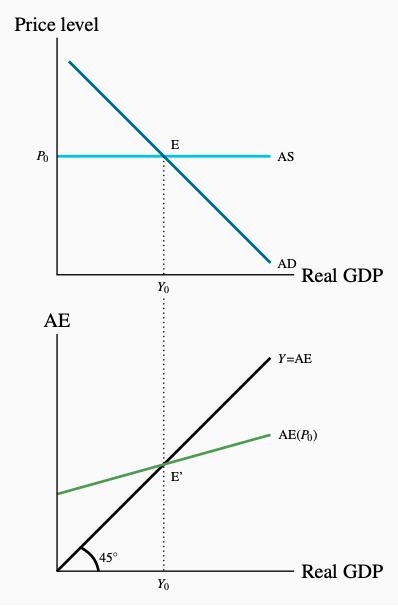6.1: Short Run Aggregate Demand and Output
- Page ID
- 11816
We concentrate first on the private market sector. Assume there are households and businesses in our simple economy, but no government. The households and businesses buy domestically produced and imported goods and services. Businesses also sell some output in export markets to residents of other countries. This model will help us to understand the mechanics that determine real output and employment and the main causes of fluctuations in real GDP. Chapter 7 will add a government sector and introduce fiscal policy. These additions will begin to make the model more realistic, but the internal mechanics will be the same. Understanding how this simple model works is key to understanding how the actual economy works.
This initial short run model has a number of crucial properties:
- All prices and wages are fixed at a given level.
- At these prices and wages, businesses produce the output that is demanded and labour accepts opportunities to work.
- Money supply, interest rates and foreign exchange rates are fixed because at this stage we ignore the financial sector.
Holding prices constant we can postpone the detailed analysis of the supply side of the economy. Total output is demand-determined. Figure 6.1 uses an AD/AS diagram like those developed in Chapter 5 to illustrate these conditions and the expenditure function we will develop.

Figure 6.1: Aggregate Demand, Aggregate Expenditure and Output
When the Price Level is Constant
The horizontal AS curve in the upper part of Figure 6.1 shows that the price level is fixed at P0, as we have assumed. As a result, the equilibrium real GDP in this example is determined by the position of the AD curve. Changes in the position of the AD curve would cause changes in real output and real income, and corresponding changes in employment. But what determines the position of the AD curve? Those things, other than price, that affect expenditure decisions. Understanding these expenditure decisions and their effects are the focus of this and the next several chapters.
The lower part of Figure 6.1 offers the first answer. It shows the relationship between planned aggregate expenditure and income when the price level is fixed. It also shows that, if the aggregate expenditure function (AE) has the right position and slope, there is a level of output at which planned expenditure and output are equal. This equality between planned expenditure and output determines the position of the AD curve. We begin our study of the interactions of expenditure, output, and income under simple conditions in this chapter. The relationships in the lower part of Figure 6.1 are the starting point.
Later we will introduce financial markets and relax the assumption that prices, wages, interest rates, and exchange rates are fixed. Not only do we want to study inflation; we also want to ask if market forces acting through changes in prices and wages would eliminate unemployment and spare capacity and move the economy to potential output. We had a first look at that process in Chapter 5, and will examine it in detail in Chapter 11.


